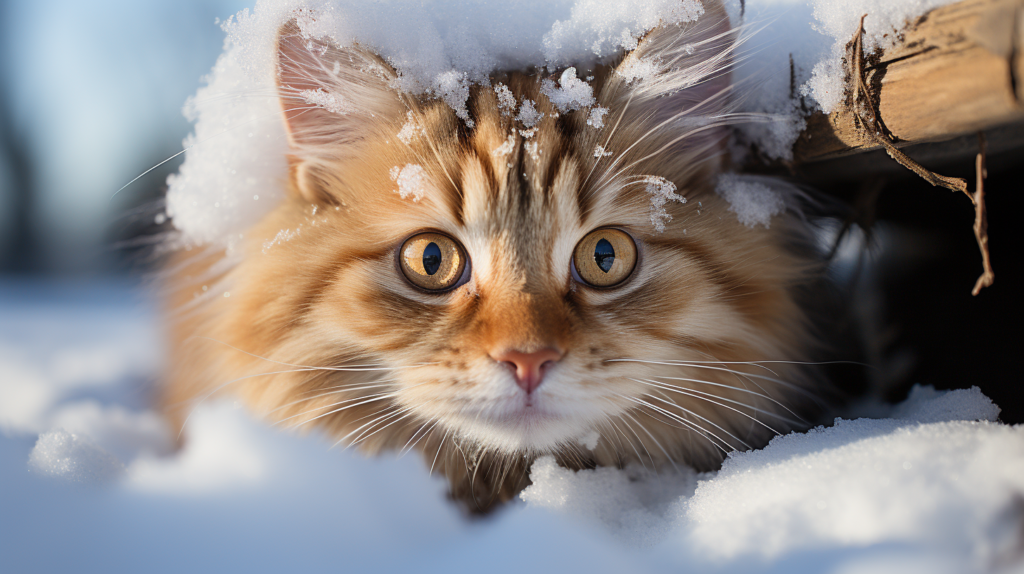Experiencing your feline friend’s cold paws can be a cause for concern, but it’s important to understand whether this is a normal occurrence for cats. When it comes to your cat’s health, paying attention to their paws is crucial. The sensation of chilly paws could indicate potential health issues, including hypothermia or poor circulation. On the other hand, a cat’s paws can naturally feel cooler than your own due to their unique physiology, such as their fur and the presence of sweat glands. In this blog post, we’ll explore the various factors that contribute to your cat’s paw temperature and when it’s time to seek veterinary care.

Assessing Feline Paw Health
The health of your cat’s paws is an important aspect of their overall well-being. By regularly assessing your cat’s paw health, you can ensure that they are comfortable and free from any potential issues. There are a few key indicators to look out for when assessing your cat’s paws, including temperature, texture, and any visible signs of damage or discomfort.
Normal Temperature Ranges for Cat Paws
A healthy cat’s paws should have a temperature similar to their body, which is usually between 101.0 and 102.5°F (38.3 to 39.2°C). You can check their paw temperature by gently feeling them with your hand. Keep in mind that their paws may feel slightly cooler than the rest of their body because of their fur and natural cooling process. If you notice any significant deviations from this range, like a temperature above 104°F (40.0°C) or below 99°F (37.2°C), it’s best to take your cat to the vet.
Signs of Abnormal Paw Temperatures
If your cat’s paw temperature falls outside of the normal range, it could be a sign of an underlying issue. Extremely cold paws may indicate poor circulation, hypothermia, or shock, while excessively warm paws could be a sign of fever or inflammation. It’s important to monitor your cat’s paw temperature regularly and seek veterinary attention if you notice any significant deviations from the normal range.
Signs of Abnormal Paw Temperatures
| Extremely Cold Paws | Poor circulation, hypothermia, or shock |
| Excessively Warm Paws | Fever or inflammation |
Factors Affecting Paw Temperature
Clearly, the temperature of your cat’s paws can be influenced by a variety of factors. Understanding these factors can help you determine if your cat’s cold paws are normal or if they may indicate an underlying health issue.
- Environmental conditions
- Circulatory health and factors
Though, it’s important to consider all potential factors when assessing your cat’s paw temperature. Here’s a breakdown of the main factors affecting paw temperature:
Environmental Conditions
Changes in the environment can have a significant impact on your cat’s paw temperature. Cold weather, drafts, or walking on cold surfaces can all lead to colder paws. On the other hand, warm and cozy surroundings can lead to warmer paws.
Circulatory Health and Factors
Recognizing the role of circulatory health and other factors is crucial in understanding your cat’s paw temperature. Poor circulation, heart disease, and other health issues can lead to consistently cold paws, which can be a cause for concern. Conversely, a healthy circulatory system can help maintain normal paw temperature.
When to be Concerned About Cold Paws

Your cat’s paws can feel slightly cooler than their body temperature at times, which is normal. However, if you notice that your cat’s paws are consistently cold to the touch, it may be a cause for concern. Cold paws can be an indication of underlying health issues, so it’s important to be aware of when it might be necessary to seek veterinary care. Paying attention to your cat’s paws can help you identify potential health problems early on.
Identifying Symptoms of Hypothermia
If your cat’s paws feel extremely cold to the touch, accompanied by shivering, lethargy, and pale gums, it could be a sign of hypothermia. Hypothermia occurs when your cat’s body temperature drops below normal, and it can be life-threatening if not addressed promptly. If you suspect that your cat is suffering from hypothermia, it’s crucial to seek immediate veterinary attention to warm them up and prevent further complications.
Conditions Linked to Cold Paws
Cold paws can be linked to various health conditions in cats, such as poor circulation, anemia, heart problems, or hypothyroidism. If your cat’s paws are consistently cold, it could be a sign of an underlying medical issue that requires professional evaluation. Keep an eye out for any other accompanying symptoms, such as weakness, loss of appetite, or changes in behavior, as these could indicate a more serious health concern.

Keeping Your Cat’s Paws Warm
Despite the natural fur coat that cats have, their paws are particularly susceptible to getting cold. Whether it’s due to cold weather, illness, or old age, it’s important to take steps to keep your cat’s paws warm and comfortable.
Preventative Measures
If you want to prevent your cat’s paws from getting too cold, there are a few things you can do. First and foremost, make sure that your home is comfortably warm. You can also consider providing an extra soft and warm bed for your cat to snuggle into. Additionally, keeping your cat indoors during severe weather can help minimize exposure to the cold. Ensuring that your cat is healthy and up to date on vaccinations is also important, as illness can make them more susceptible to the cold.
Tips for Managing Cold Paws
If your cat’s paws are already cold, there are a few steps you can take to help warm them up. One option is to use a pet-safe heating pad to provide a warm spot for your cat to relax. You can also consider using pet-safe booties to insulate and protect your cat’s paws during outdoor excursions. Additionally, paying attention to your cat’s behavior and body language can help you determine if their paws are cold. Regularly checking for signs of discomfort such as licking or biting at their paws can help you address the issue promptly. The bottom line is, keeping your cat’s paws warm is essential for their overall health and well-being.
FAQ
Why are my cat’s paws cold?
Cat paws can feel colder than the rest of their body due to their unique physiology. Factors such as fur and the natural cooling process through perspiration can contribute to the coolness of their paws.
Is it normal for my cat’s paws to be colder than mine?
Yes, it is normal for a cat’s paws to feel slightly cooler than your own. This is primarily because of their fur and the natural cooling process of their paws through perspiration.
What are the normal temperature ranges for cat paws?
The temperature of a healthy cat’s paws should generally be consistent with the rest of their body temperature, which typically ranges from 101.0 and 102.5°F (38.3 to 39.2°C).
What are the potential health issues associated with cold cat paws?
Extremely cold paws may indicate poor circulation, hypothermia, or shock. Conversely, excessively warm paws could be a sign of fever or inflammation. It’s important to monitor your cat’s paw temperature regularly and seek veterinary attention for significant deviations from the normal range.
How can I keep my cat’s paws warm?
To keep your cat’s paws warm, ensure your home is comfortably warm and provide an extra soft and warm bed for them. Keeping your cat indoors during severe weather can also minimize exposure to the cold. Using pet-safe heating pads or booties during outdoor excursions can help warm their paws.

Hello there, I am Iftekhar Ahmed. I am the owner of Mishka & The Cat Corners. I love to explore and write on various topics about cats

